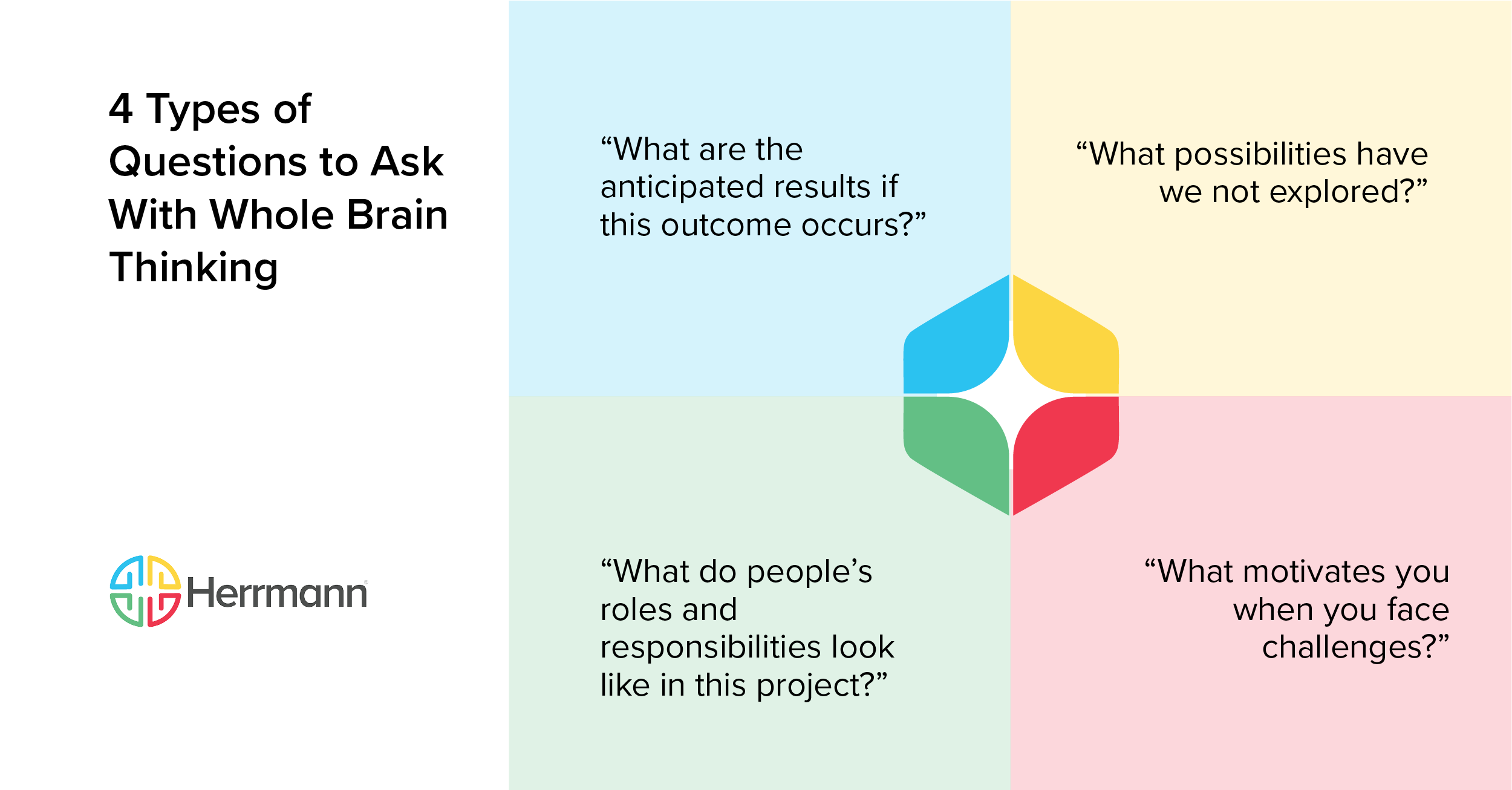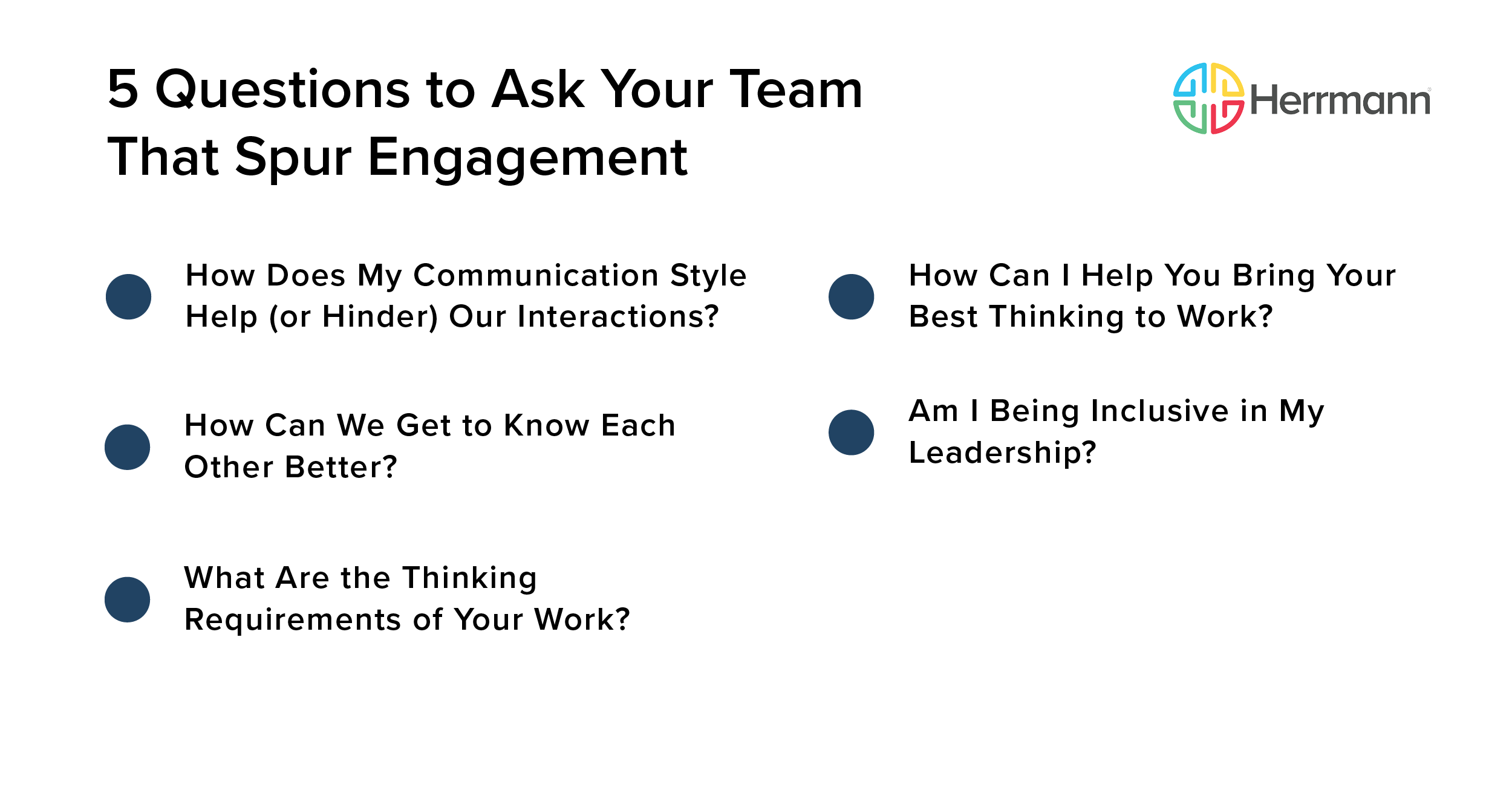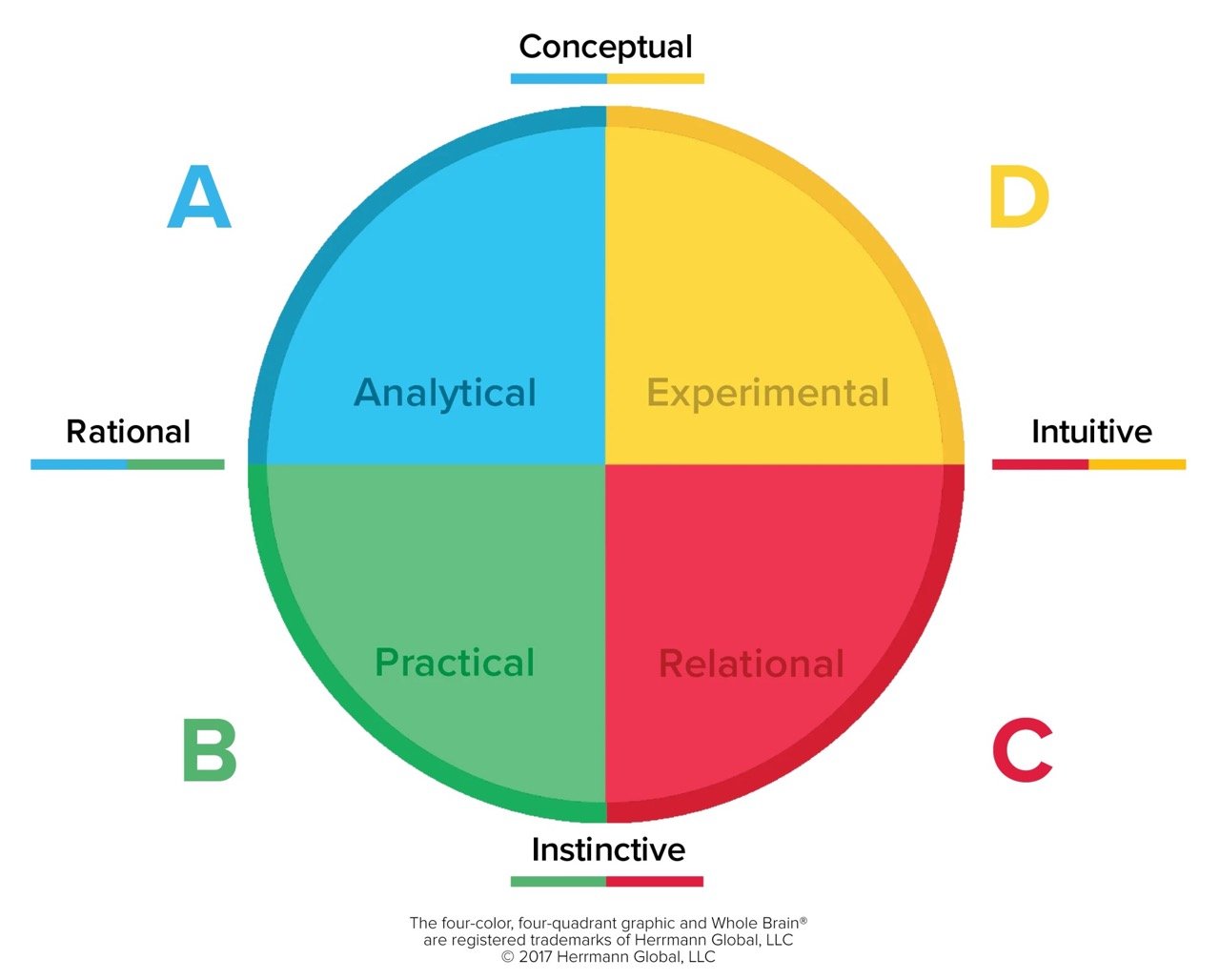What’s the difference between a thriving, close-knit team that’s eager to tackle problems and a disgruntled group of people with one eye on their next job? Employee engagement. Leaders can’t change their teams overnight, but asking the right employee engagement questions can help them uncover what energizes their people — and what’s demoralizing them.
Employee engagement might not always be visible, but the business impact is real. Seventy-two percent of employees at best-practice organizations are engaged at work, according to Gallup survey results, compared with only 23% of all employees globally. Failing to engage your workforce has consequences, as 51% of employees globally are job hunting or open to other opportunities.
Read on to explore five essential questions leaders can ask their teams to cultivate employee engagement. Find out how Whole Brain® Thinking can help leaders ask better questions that connect with people of all backgrounds and ways of thinking.
What Does Employee Engagement Look Like?
Employee engagement is the level of enthusiasm and commitment an employee has toward their work. Engaged employees understand the company's mission and feel connected to it. They feel like they’re part of a team, that their work is valued, and that they’re recognized for their hard work.
When employees are engaged, they're more productive and creative and have higher morale. Profitability increases while turnover, employee absenteeism and theft, and safety issues all decline, according to Gallup.
Engagement can be measured directly, including through annual employee engagement survey questions or more frequent pulse surveys. You also can measure employee engagement indirectly. Turnover and retention, absenteeism, and employee Net Promoter Score are just a few metrics that can signal whether you have bigger problems.
How Whole Brain® Thinking Helps Leaders Improve Employee Engagement
Whole Brain® Thinking is a powerful tool for leaders to help their teams build a common language around cognitive diversity. The result is better communication, effectiveness, engagement, trust, and psychological safety.
The Whole Brain® Thinking methodology leverages four distinct thinking styles, grouped by quadrants: Analytical (Blue), Practical (Green), Relational (Red), and Experimental (Yellow). While people have stronger preferences for one or more quadrants, they can and do use each thinking style in their day-to-day lives. There’s no ideal or best combination of thinking preferences, nor any negative or discouraged groupings.
When leaders and teams understand their thinking preferences, they can approach problems more thoughtfully and view differences as opportunities. This embrace of difference is at the heart of cognitive diversity. You want teams to see value in other experiences, backgrounds, and thinking characteristics rather than labeling them as obstacles or troubling. When teams leverage their collective diversity, they become more open-minded, agile, collaborative, innovative, and productive.
Whole Brain® Thinking helps leaders ask employee engagement questions that are rooted in one or more quadrants. For example, because analytical thinking focuses on logic, measurable data, and facts, leaders can draw out Blue perspectives with questions such as “What are the anticipated results if this outcome occurs?” or “What evidence do you have for your hypothesis?”
Practical (Green) thinking is often characterized by organization and sequence. If you’re tackling a particularly large or novel challenge, leaders might want to break the problem into manageable chunks and set a deadline. Practical thinking can embrace the opportunity to bring order, assign responsibility, and provide a road map. By creating structure, teams can focus on other activities, such as innovation and team-building.
Leaders looking to elicit practical thinking might ask questions such as, “What do people’s roles and responsibilities look like in this project?” or “Who will be the project manager, and how frequently will you give updates?”
Sign up to our newsletter for the latest insights
Finally, you can ask questions that inspire out-of-the-box thinking and help experimental (Yellow) thinkers feel comfortable sharing ideas. These include “What other solutions could we try?” or “What possibilities have we not explored?” They also can use this approach to solicit team meeting ideas that help their people be more collaborative.

5 Open-Ended Questions to Ask Employees for Better Engagement
Organizations should use employee engagement surveys and other formalized approaches to measure, understand, and improve employee engagement. Leaders also play a role in understanding team members’ engagement, and they can use everyday conversations to build trust and elicit feedback.
Here are some open-ended questions for employee engagement that encourage your team to share what’s on their minds — and how you can improve the workplace.
How Does My Communication Style Help (or Hinder) Our Interactions?
It’s natural to assume that others share your thinking preferences. That approach can be effective for those who think and approach situations similarly to you.
Of course, the truth is that your preferences for communication and problem-solving aren’t universal. People respond differently to different communication styles based on their experiences, thinking preferences, and how they prefer to be directed. Similarly, not everyone interprets tone of voice or body language in the same way.
The most effective leaders understand that people communicate in different ways. They know they have blindspots in their communication (and their listening). Checking in with employees about your communication style helps both parties feel safe recognizing their similarities and differences, as well as figuring out how to get on the same page.
As part of this approach, take time for self-reflection. Ask yourself questions like:
- Do I connect with certain people easily and pay more attention to their ideas over others?
- Do some struggle with my directions while others have no trouble?
How Can We Get to Know Each Other Better?
Knowing your employees is essential for fostering an environment of collaboration, ownership, and engagement. Leaders must take the time to understand each employee's experience, mindset, strengths and weaknesses, and how they respond to different leadership styles.
Start with job-specific information. Do you understand your employees’ expectations, job roles, and skill sets? Do you know what they work on daily — and what might cause unnecessary roadblocks?
Asking employees how you can get to know each other better also gives them a chance to inquire about you. What don’t they understand about your approach, your thinking, or your responsibilities?
What Are the Thinking Requirements of Your Work?
A key priority for every leader should be aligning their people with the work they do best and find most stimulating — all while encouraging them to stretch outside their mental comfort zone when the job requires it. That’s the essence of Whole Brain® Thinking preferences — you might prefer an analytical and practical approach to work situations, but sometimes you’ll need to stretch and be more experimental or focus on interpersonal issues.
In any workplace, there are thinking requirements that employees must meet to complete tasks. Leaders need to understand those requirements and ensure that employees have the skills, knowledge, and resources necessary to meet them.
As you inquire about the types of thinking required for your team members’ work, consider how these key elements of thinking come into play:
- Problem-solving: Teams with cognitive diversity recognize that there are many ways to solve problems. Leaders can ask their teams to explore new solutions without punishing them for an idea that doesn’t pan out.
- Decision-making: One way to build engagement is to give teams as much autonomy as possible while providing guidance and guardrails that protect the organization’s interests and keep projects on track.
- Mental models and frameworks: Mental models are systematic explanations for understanding complex concepts and systems, while frameworks can be used for tackling projects or tasks in an organized manner. Leaders should encourage their teams to learn about different mental models and frameworks to work more efficiently and effectively with each other.
- Critical and creative thinking: Critical thinking involves analyzing data and evaluating evidence to make informed decisions, while creative thinking has teams look at problems from different perspectives and beyond existing solutions. Leaders should encourage their teams to engage in both types of thinking, embracing everyone’s distinct insights, skills, and perspectives.
How Can I Help You Bring Your Best Thinking to Work?
While nobody is at their best 100% of the time, leaders can do more to understand the roadblocks hindering employees from being their best selves and engaging with their work. When you ask this question, be prepared for answers that might require additional follow-up or trial and error.
For instance, if an employee says working remotely helps them think best, you might need to balance that against on-site requirements or the benefits of in-person collaboration. A way forward in this scenario might be to adopt a hybrid approach or to find a space in the office for this person to have heads-down time for deep thinking.
Am I Being Inclusive in My Leadership?
Now more than ever, we need the diversity of the organization’s thinking working to solve problems and find better ways of doing things. For leaders, that means listening to and valuing all the thinkers on the team, even — especially — those whose perspectives are different from their own.
This open-ended question can be difficult for employees to feel comfortable asking. They might need time to think through the question and collect their thoughts. Likewise, employees might have tough feedback about how they view your inclusiveness versus your perception. Don’t dismiss their feedback; instead, ask how they might be correct and how you could be more inclusive in your words, actions, and decisions.

Use Engagement Questions to Strengthen Your Team
Employee engagement is a bellwether for organizational happiness, productivity, and retention. If you want to understand and improve engagement on your team, you need to investigate. While your organization can look at high-level metrics, including surveys, team leaders also play a role.
Lean on open-ended employee engagement questions to encourage employees to speak their minds and give you valuable insight into the dynamics of your team. Then, apply Whole Brain® Thinking to better understand how people’s thinking preferences affect their engagement — and how you can meet them where they are.
Want to continue improving your communication? Download our guide to communicating with different thinkers.


-1.png?width=1200&name=5%20Employee%20Engagement%20Questions%20to%20Ask%20Your%20Team%20(1)-1.png)










